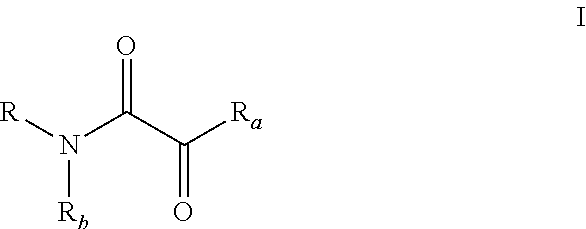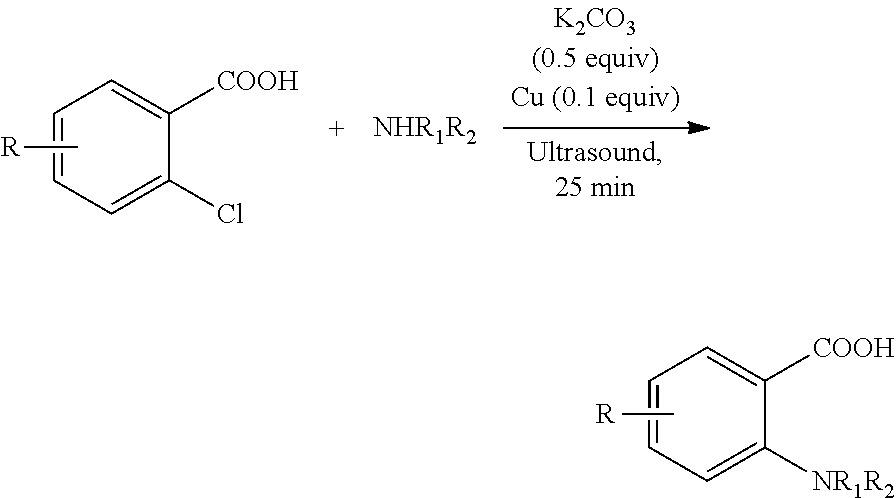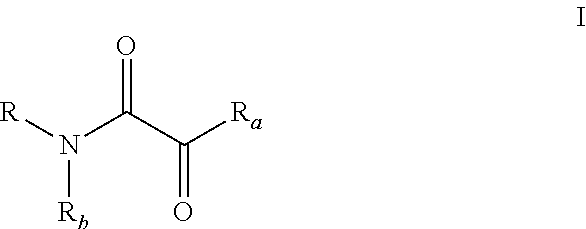Oxalic acid monoamide ligand, and uses thereof in coupling reaction of copper-catalyzed aryl halogen substitute
a technology of oxalic acid monoamide and aryl halogen substitute, which is applied in the field of organic synthesis, can solve the problems of difficult coupling reaction, limited substrates of copper-catalyzed coupling reaction reported so far, and achieve the effect of efficient reaction
- Summary
- Abstract
- Description
- Claims
- Application Information
AI Technical Summary
Benefits of technology
Problems solved by technology
Method used
Image
Examples
example 1
of Ligands (L-I-27, L-II-9, L-II-31 as Examples)
[0252]Process i:
[0253]2,4,6-Trimethoxyaniline (30 mmol) and triethylamine (36 mmol) were dissolved in 150 mL of tetrahydrofuran, and the concentration of 2,4,6-trimethoxyaniline was 0.2 mol / L. The mixture was cooled in an ice-water bath, and stirred. Then oxalyl chloride monomethyl ester (33 mmol) was added dropwise, the system became cloudy and triethylamine hydrochloride was produced. After the addition was completed, ice water bath was removed, and mixture was naturally restored to room temperature, and stirring was continued for 1 to 2 hours until 2,4,6-trimethoxyaniline was completely consumed (monitored by TLC).
[0254]Then the reaction mixture was filtered and triethylamine hydrochloride was removed. The filter cake was rinsed with a small amount of tetrahydrofuran (Do not flush with ethyl acetate, otherwise triethylamine hydrochloride will be dissolved). After the filtrate was concentrated, the residue was purified by silica gel ...
example 2
Synthesis of N-benzyl-4-methylaniline By Coupling Reaction of 1-chloro-4-methylbenzene with Benzylamine
[0267]
[0268]Copper (I) iodide (0.05 mmol), ligand (0.1 mmol) and potassium phosphate (1.0 mmol) were added into a 10 mL of Schlenk tube. The tube was then evacuated and backfilled with argon (this sequence was repeated three times), and then 1-chloro-4-methylbenzene (0.5 mmol), benzylamine (0.75 mmol) and 1 mL of DMSO were added. The reaction mixture was stirred well at 120° C. for 24 hours. After cooling, water and ethyl acetate were added and the mixture was separated. The aqueous phase was extracted twice with ethyl acetate. The combined organic phase was dried over anhydrous sodium sulfate. After concentration, the residue was purified by column chromatography (petroleum ether: ethyl acetate=50: 1) to give the product N-benzyl-4-methylaniline (89 mg, yield 91%).
[0269]1H NMR (400 MHz, CDCl3) δ 7.34-7.21 (m, 5H), 6.96 (d, J=8.0 Hz, 2H), 6.54 (d, J=8.4 Hz, 2H), 4.28 (s, 2H), 3.88 ...
example 3
Synthesis of N-benzyl-4-methylaniline By Coupling Reaction of 1-chloro-4-methylbenzene with Benzylamine
[0270]The operation of this example is the same as that of Example 2 except that different oxalic amide ligands were used. The results are shown in the following table.
LigandYield / %LigandYield / %LigandYield / %L-I-162L-II-975L-II-3892L-I-264L-II-1352L-II-3186L-I-765L-II-1417L-II-2966L-I-2362L-II-773L-II-2745L-I-2259L-II-1556L-II-3382L-I-2444L-II-1611L-II-3673L-I-2774L-II-2461L-II-2817L-I-955L-II-1840L-II-3457L-I-867L-II-156L-II-3521L-I-2575L-II-860L-II-3065L-I-3140L-II-564L-II-3776L-I-3234L-II-674L-II-481L-I-3617L-II-4162L-II-1940L-II-2070L-II-2165L-II-2225L-II-2360L-I-437L-I-3420L-I-3964L-II-61L-II-5946L-II-6010L-II-5881L-II-6263L-II-6376L-II-6689L-II-6492L-II-6544L-II-67L-II-6923L-II-7048L-II-6861L-II-7277L-II-7187L-II-7388L-II-7485
PUM
| Property | Measurement | Unit |
|---|---|---|
| molar ratio | aaaaa | aaaaa |
| molar ratio | aaaaa | aaaaa |
| reaction temperature | aaaaa | aaaaa |
Abstract
Description
Claims
Application Information
 Login to View More
Login to View More - R&D
- Intellectual Property
- Life Sciences
- Materials
- Tech Scout
- Unparalleled Data Quality
- Higher Quality Content
- 60% Fewer Hallucinations
Browse by: Latest US Patents, China's latest patents, Technical Efficacy Thesaurus, Application Domain, Technology Topic, Popular Technical Reports.
© 2025 PatSnap. All rights reserved.Legal|Privacy policy|Modern Slavery Act Transparency Statement|Sitemap|About US| Contact US: help@patsnap.com



